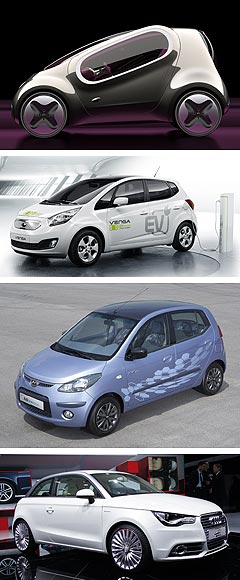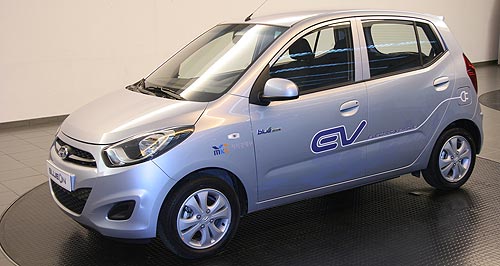Make / Model Search
Future models - Hyundai - BlueOnFirst look: Hyundai unveils BlueOn EVFull speed ahead: Hyundai claims that its first “full-speed electric vehicle” is capable of 130km/h, with a range of 140km between charges. Hyundai transforms i10 Electric into ‘BlueOn’ to take on Mitsubishi’s i-MiEV13 Sep 2010 By TERRY MARTIN HYUNDAI has unveiled a more powerful version of its all-electric i10 micro-car, which is now dubbed ‘BlueOn’ and will enter small-scale production of 2500 units by the end of 2012. This was the deadline Hyundai had targeted for mass production of its first electric vehicle, subject to improvements in battery technology – and a reduction in battery cost – which now look to have been achieved with the uprated performance from SK Energy-supplied lithium-ion polymer (LiPoly) batteries. Launched in a facelifted version of the i10, which in conventional-engine form is expected to reach the Australian market next year, the BlueOn has a battery capacity of 16.4kWh.  From top: Kia Pop concept, Kia Venga EV, Hyundai i10 Electric, Audi A1 e-Tron. From top: Kia Pop concept, Kia Venga EV, Hyundai i10 Electric, Audi A1 e-Tron.The BlueOn can consequently produce a maximum 61kW of power and 210Nm of torque from its electric motor – a considerable improvement over the i10 Electric prototype, which used a 16kWh LiPoly battery and produced 49kW. At last year’s Frankfurt motor show, Hyundai claimed the i10 Electric – which was scheduled to be leased in limited numbers this year – offered a 160km driving range, 0-100km/h acceleration of 15 seconds and a 130km/h top speed, with full recharging achieved within five hours using a 220-volt household outlet (or 85 per cent in less than 15 minutes with a 413-volt current). With the BlueOn, Hyundai says the driving range on a single charge is 140km and the vehicle can reach 100km/h from standstill in 13.1 seconds, still with a maximum speed of 130km/h. The company claims it can be fully recharged on 220 volts within six hours, while a quick charge via 380 volts can enable 80 per cent capacity within 25 minutes. At first glance, the BlueOn compares favourably with Mitsubishi’s pioneering i-MiEV, which uses a 16kWh lithium-ion battery pack, produces 47kW/180Nm, takes 15 seconds to reach 100km/h, has a 130km/h top speed, a 130km driving range and requires seven hours for a full recharge using household power. It will be interesting to see what Hyundai’s sister brand Kia claims with its all-electric Pop micro-car concept to be unveiled at the Paris motor show on September 30. Kia’s larger Venga mini-MPV, which debuted at the Geneva motor show in March, was fitted with a twin-pack 24kWh LiPoly battery and offered 80kW and 280Nm. The driving range on a single charge was higher at 180km, its acceleration from 0-100km/h was claimed to be 11.8 seconds, top speed was listed at 140km/h, and recharging time on a conventional outlet was eight hours. Hyundai said this week that it will collaborate with the Seoul Metropolitan Government and other government agencies to build public recharging points, and that a fleet of 30 prototype vehicles will be rolled out to various government departments to develop and test the charging infrastructure over the next two years. Described as Hyundai’s – and Korea’s – first full-speed electric vehicle (FSEV), the BlueOn is slightly larger than the i-MiEV at 3585mm in length, 1595mm in width and 1540mm in overall height. Hyundai said it developed the BlueOn over a one-year period, with an investment of approximately $A37.2 million, although it is unclear whether this also includes i10 Electric R&D. It said the vehicle is designed to prevent overcharging and that hundreds of thousands of kilometres of endurance testing have already been conducted “to ensure safety”. Among its safety features is a Virtual Engine Sound System (VESS), which creates an artificial sound for the safety of pedestrians, particularly when travelling at low speeds. Other aspects specific to the BlueOn include an electric motor-driven power steering system, electric water pump, a regenerative braking system, and an onboard telematics system showing the charge status and location of recharging stations. Also in the cabin is a 10.5cm TFT LCD ‘Supervision Cluster’ providing voice guidance. Hyundai’s corporate R&D centre vice-chairman Hyun-Soon Lee said the Korean company is dedicated to reducing its carbon footprint and satisfying market needs. “We are proud to introduce the world to BlueOn, which was fully developed in Korea and displays Hyundai’s latest technological advancements,” he said. “Consumers’ interests and demand for eco-friendly cars are rising, and securing such advanced technology is critical in becoming an industry leader.” The ‘BlueOn’ moniker derives from the company’s Blue Drive sub-brand, with ‘on’ symbolising ‘switch on’. At Geneva earlier this year, Hyundai applied Blue Drive to the i10, i20 and i30 models, introducing measures such as engine idle-stop, gear ratio optimisation, low-rolling-resistance tyres and underbody panels. For the 1.0-litre i10 Blue that will soon become available in Europe, the overall result lowered CO2 emissions to 99g/km. Meanwhile, Audi started a trial of its A1 e-Tron plug-in hybrid in Germany last week, with 20 examples to hit the road gradually in Munich over the next nine months, serviced by 200 recharging stations to be built by the middle of next year. The project is sponsored by the German federal transport department and will study a variety of EV issues, including the power grid and data transfer between the driver, vehicle and recharging station. It will also include a test of ‘smart phones’ as the central interface for the driver. Also unveiled at the Geneva motor show in March, the A1 e-Tron has a 12kWh 380-volt lithium-ion battery pack and, combined with an electric motor and a small single-rotor rotary engine, produces 75kW/240Nm. Audi says it can manage 50km on purely electric power, with the internal combustion engine extending the range by another 200km. German transport minister Peter Ramsauer said: “Electromobility is not an abstract technology issue. At its core is the question of how the transportation systems of the future should look. We are therefore funding electromobility under real-world conditions in our model regions – a large field test, so to speak. “Projects like these provide us with important insight into how to make electromobility a success, both in the city and in rural areas. “In the Munich model region, we are providing approximately €10 million ($A13.7m) in funding for electromobility. This money is a smart investment in the future. “Our goal is clear: We want to make Germany the lead market for electromobility and put at least one million electric vehicles on German roads by 2020.”  Read more19th of August 2010  Paris show: Kia ‘pops’ out an all-electric city carKia takes the wraps off electric Pop micro-car concept ahead of Paris premiere1st of June 2010  Small cars go electricSmall-car segment to become battleground for range of new hybrid and EV models in Oz2nd of March 2010  Geneva show: Kia lights up with its first EVProduction-oriented Venga EV marks Kia’s first application of a full-EV powertrainAll future models Alfa Romeo Alfa Romeo Abarth Abarth Alpine Alpine Alpina Alpina Audi Audi Aston Martin Aston Martin BMW BMW Bentley Bentley Chery Chery Brabham Brabham Chrysler Chrysler Chevrolet Chevrolet Cupra Cupra Citroen Citroen DS DS Dodge Dodge Fiat Fiat Ferrari Ferrari Foton Foton Ford Ford Great Wall Great Wall FPV FPV Haval Haval GWM GWM Honda Honda Holden Holden Hummer Hummer HSV HSV Infiniti Infiniti Hyundai Hyundai Jaguar Jaguar Isuzu Isuzu Kia Kia Jeep Jeep Land Rover Land Rover Lamborghini Lamborghini Lexus Lexus LDV LDV Mahindra Mahindra Lotus Lotus Mazda Mazda Maserati Maserati Mercedes-AMG Mercedes-AMG McLaren McLaren MG MG Mercedes-Benz Mercedes-Benz Mitsubishi Mitsubishi Mini Mini Opel Opel Nissan Nissan Peugeot Peugeot Pagani Pagani Proton Proton Porsche Porsche Renault Renault Ram Ram Rover Rover Rolls-Royce Rolls-Royce Skoda Skoda Saab Saab SsangYong SsangYong Smart Smart Suzuki Suzuki Subaru Subaru Toyota Toyota Tesla Tesla Volvo VolvoMotor industry news |
Click to shareHyundai modelsResearch Hyundai All future models Alfa Romeo Alfa Romeo Abarth Abarth Alpine Alpine Alpina Alpina Audi Audi Aston Martin Aston Martin BMW BMW Bentley Bentley Chery Chery Brabham Brabham Chrysler Chrysler Chevrolet Chevrolet Cupra Cupra Citroen Citroen DS DS Dodge Dodge Fiat Fiat Ferrari Ferrari Foton Foton Ford Ford Great Wall Great Wall FPV FPV Haval Haval GWM GWM Honda Honda Holden Holden Hummer Hummer HSV HSV Infiniti Infiniti Hyundai Hyundai Jaguar Jaguar Isuzu Isuzu Kia Kia Jeep Jeep Land Rover Land Rover Lamborghini Lamborghini Lexus Lexus LDV LDV Mahindra Mahindra Lotus Lotus Mazda Mazda Maserati Maserati Mercedes-AMG Mercedes-AMG McLaren McLaren MG MG Mercedes-Benz Mercedes-Benz Mitsubishi Mitsubishi Mini Mini Opel Opel Nissan Nissan Peugeot Peugeot Pagani Pagani Proton Proton Porsche Porsche Renault Renault Ram Ram Rover Rover Rolls-Royce Rolls-Royce Skoda Skoda Saab Saab SsangYong SsangYong Smart Smart Suzuki Suzuki Subaru Subaru Toyota Toyota Tesla Tesla Volvo VolvoMotor industry news |











Facebook Twitter Instagram